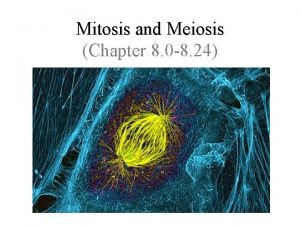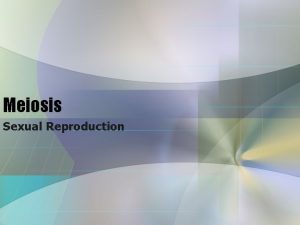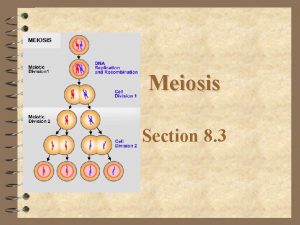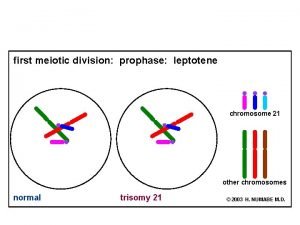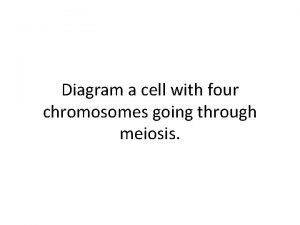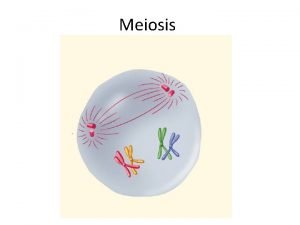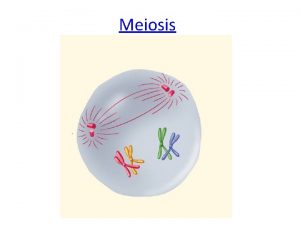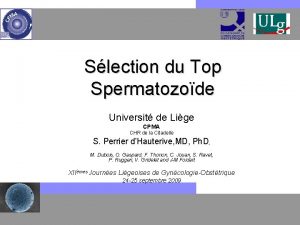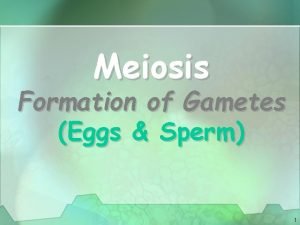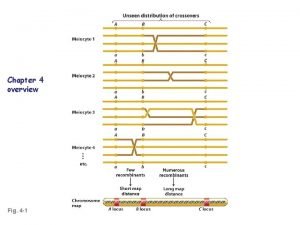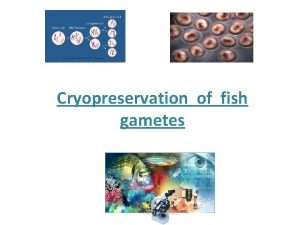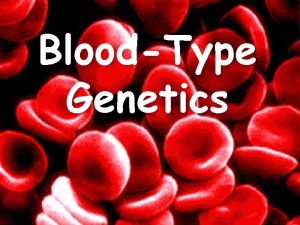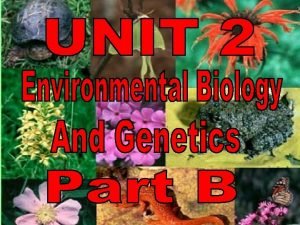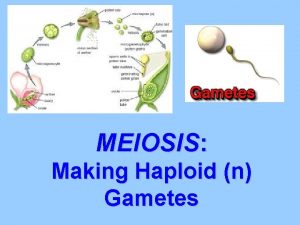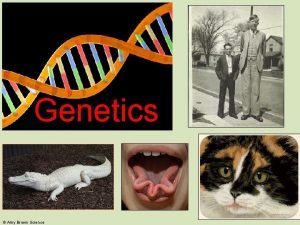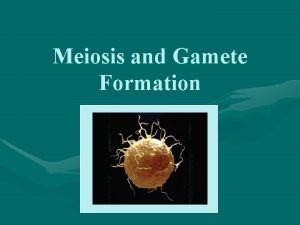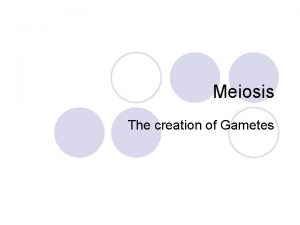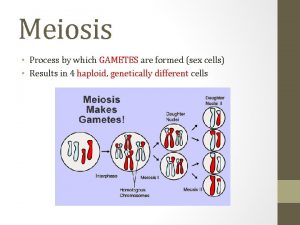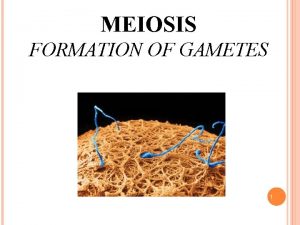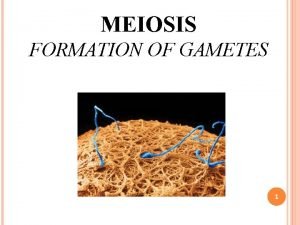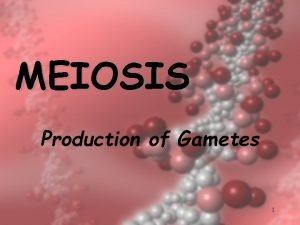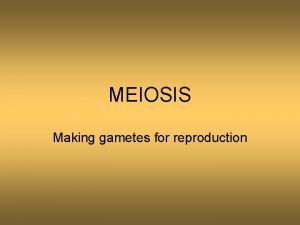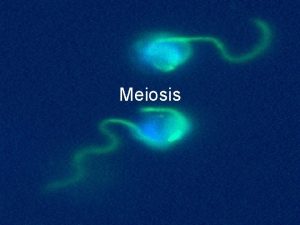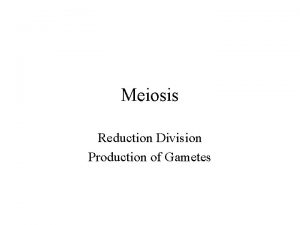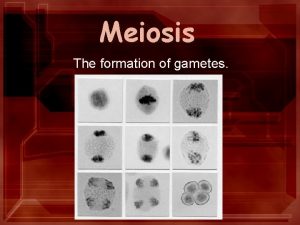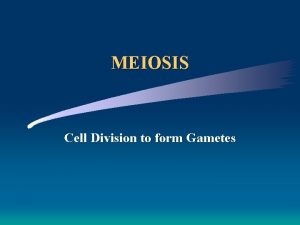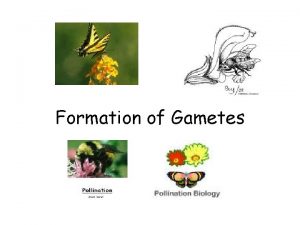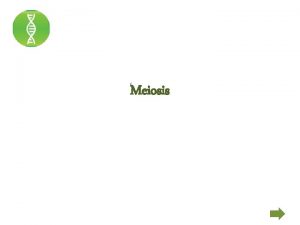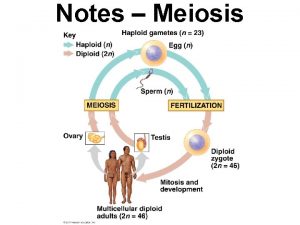Meiosis Meiosis is the process in which gametes





















- Slides: 21

Meiosis

Meiosis is the process in which gametes (sex cells) are formed Each gamete formed will have one-half of each homologous pair of chromosomes Homologous chromosomes = corresponding chromosomes from each parent

Meiosis Has two parts; Meiosis 1, and Meiosis 2. In Males, meiosis occurs in testes In Females, meiosis occurs in the ovaries Chromosomes replicate before meiosis begins

Interphase The same thing happens during Interphase of mitosis as meiosis Mitosis . Meiosis

Prophase I Same thing occurs in Meiosis and Mitosis The only difference is the location that the spindles attach to the chromosomes Mitosis Meiosis

Prophase I In Meiosis only, there maybe some crossing-over of parts of chromosomes This is where arms of chromosomes swap places when they are pulled to other sides of the cell

Crossing Over Crossing over allows for different gene combinations This is known as genetic recombination Basically, this increases the variety of gene combinations

Metaphase I Notice the location of the chromosomes lining up Mitosis Dyads line up in the middle of the cell Meiosis Tetrads line up in the middle of the cell

Anaphase I Paired chromatids and chromosomes are pulled to opposite poles Mitosis Meiosis

Telophase I Nuclear membrane(s) begin(s) to reappear. In Meiosis, cells have only one set of replicated chromosomes each. Mitosis Meiosis

Cytokinesis The cytoplasm of the cell divides forming two new daughter cells. The same thing occurs in Mitosis and Meiosis. Mitosis Meiosis

At this point, Mitosis is complete. The end result of Mitosis is two diploid daughter cells that are genetically identical. Diploid = a cell that contains a full set of homologous chromosomes Meiosis continues…

Prophase II Spindles reform – NO REPLICATION has occurred, each cell contains half of the chromosomes it started with, each linked pair are identical chromatids. E N Mitosis O D Meiosis

Metaphase II Paired chromatids line up at equator, and two spindle fibers, one from each pole, attach to a centromere E N O D Mitosis Meiosis

Anaphase II Centromere divides and each chromatid is pulled to the opposite pole O D E N Mitosis Meiosis

Telophase II Nuclear membrane(s) begin to reappear. Chromosomes O D begin to unravel. E N Mitosis Meiosis

Cytokinesis The two daughter cells divide, producing four new haploid cells E N Mitosis O D Meiosis

End Result Meiosis is now complete. End result of Meiosis is four haploid daughter cells that are NOT genetically identical. Haploid = containing a single set of chromosomes

Meiosis in Males (spermatogenesis) Occurs in the testes At the end of Meiosis I, two Secondary Sperm have been formed. At the end of Meiosis II, four Sperm have been formed, which produce a flagellum for locomotion

Meiosis in Females (oogenesis) • Primary eggs (oocytes) are formed before birth of the mother • Unequal division of cytoplasm occurs at the end of Meiosis I, forming one Secondary (egg) Oocyte and One Polar Body

Meiosis in Females (oogenesis) • The polar body may divide, but will NOT produce fertile egg • Unequal division of the cytoplasm also occurs at the end of Meiosis II, forming an egg (ootid, which becomes a mature egg), and a 2 nd polar body).
 Aim of mitosis
Aim of mitosis Meiosis
Meiosis Meiosis makes gametes
Meiosis makes gametes Leptotene
Leptotene Meiosis makes gametes
Meiosis makes gametes Process of gametes
Process of gametes Meiosis
Meiosis Two traits punnett square
Two traits punnett square Cpma citadelle
Cpma citadelle Somatic cells vs gametes
Somatic cells vs gametes Replicated chromosome
Replicated chromosome Foil method biology
Foil method biology Bbdd x bbdd
Bbdd x bbdd Foil method gametes
Foil method gametes Foil method punnett square
Foil method punnett square Gametes
Gametes Cryopreservation of fish gametes
Cryopreservation of fish gametes Blood type genetics
Blood type genetics Gametes
Gametes 2n haploid or diploid
2n haploid or diploid Describe gametes
Describe gametes Who is the
Who is the
